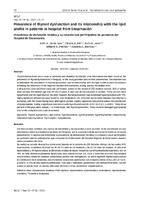Prevalence of thyroid dysfunction and its relationship with the lipid profile in patients in hospital from Encarnación
Date
2021-05-20Author
Génez Yeza, Edith Noemí
Mir, Claudia Nora
Ares, Rocio Mellory
Pedrozo, Williams René
Bonneau, Graciela Alicia
Metadata
Show full item recordAbstract
Thyroid dysfunctions are a cause of morbidity and disability worldwide. Little information has been found on the prevalence of thyroid dysfunctions in Paraguay, so this study provides data on their presentation. The objective was to determine the prevalence of thyroid dysfunction and its relationship with the lipid profile in adult outpatients attending the laboratory of the Regional Hospital of Encarnación, during January-November 2016. A descriptive cross-sectional study was performed, based on the review of 250 medical records, 84% of whom were women; the median age was 39 (35-47) years in men and 36 (32-43) years in women. Thirty percent were hypothyroid and 3% hyperthyroid; the most frequent thyroid dysfunction was subclinical hypothyroidism with 19%. Highly significant differences were found for total cholesterol, LDL, VLDL and thyrotrophin between hypothyroid vs euthyroid, with the former having more atherogenic profiles. Logistic regression was used to assess the contribution of dyslipidaemia, finding a significant association with hypothyroidism (OR=3.24(1.81-5.81), p<0.001). Thirty-three percent of this population sample, 1 in 3 individuals, had thyroid dysfunction. These could be managed appropriately and further complications could be avoided. Las disfunciones tiroideas son causas de morbilidad y discapacidad a nivel mundial. Se ha encontrado escasa información sobre la prevalencia de estas en Paraguay, por lo que este trabajo aporta datos sobre su forma de presentación. El objetivo fue determinar la prevalencia de disfunciones tiroideas y su relación con el perfil lipídico en pacientes adultos ambulatorios que concurrieron al laboratorio del Hospital Regional de Encarnación, durante enero-noviembre del 2016. Se realizó un estudio descriptivo-transversal, basado en la revisión de 250 historias clínicas, de las cuales 84% eran mujeres; la mediana de edad fue 39 (35-47) años en los hombres y 36 (32-43) años las mujeres. El 30% eran hipotiroideos y 3% hipertiroideos; la disfunción tiroidea de mayor frecuencia fue el hipotiroidismo subclínico, con un 19%. Se halló diferencia altamente significativa para colesterol total, LDL, VLDL y tirotrofina entre los hipotiroideos vs eutiroideos, donde los primeros presentaban perfiles más aterogénicos. Se utilizó regresión logística para evaluar la contribución de la dislipemia, encontrándose asociación significativa con el hipotiroidismo (OR=3,24(1,81-5,81), p<0,001). El 33% de esta muestra poblacional, 1 de cada 3 individuos, presentaron una disfunción tiroidea. Con los cuales se podría tener un manejo adecuado de estas y evitar posteriores complicaciones.
Collections
The following license files are associated with this item:



